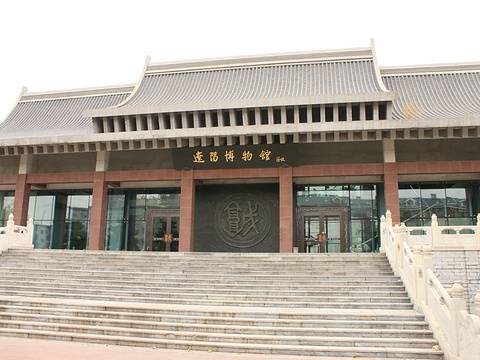Guangyou Temple was built during the Han Dynasty and is one of the earliest Buddhist temples in China. It reached its peak during the Ming and Qing Dynasties. In the Zhonghua Square within the Guangyou Temple scenic area stands an imposing five-gate, six-pillar bluestone archway. The temple houses a gilded wooden statue of Shakyamuni Buddha, which is one of the most famous wooden gilded Buddha statues in the world today. Guangyou Temple is grand and magnificent. The bluestone archway in front of the mountain is 34 meters wide and 16 meters high, with five gates and six pillars. It is large in size and intricately carved, making it a representative work of Chinese stone archways. On both sides of the main gate, there are bronze sculptures. On the left is a depiction of a carriage procession, and on the right is a mural of a carriage procession from the Han Dynasty, vividly showcasing the lively scenes of Liaodong officials traveling, reflecting the Han and Wei styles of ancient Xiangping in the Northeast region. The right side also features a depiction of ascending to immortality on a crane, derived from folklore.
Liaoyang White Pagoda is located at Section 1, Zhonghua Street, in front of Liaoyang Station, situated within White Pagoda Park in the northern suburbs of Liaoyang City. The White Pagoda is one of the six major high towers in China and is a national key cultural relic protection unit. The Liaoyang White Pagoda, grand and ancient, was initially built during the Liao and Jin periods. After several generations of repairs, it still retains the appearance of its initial construction. Originally called the Guangyou Temple Pagoda, the White Pagoda got its name because its body is coated with white lime. The white pagoda body is made of bricks, with an octagonal thirteen-story structure and a dense eaves style, with a total height of 70.4 meters. It consists of four parts: the base, the body, the eaves, and the finial. The body of the pagoda is adorned with brick carvings of seated Buddhas, attendants, and flying deities on its eight sides, all exquisitely crafted. Each level of the pagoda has wind chimes and bronze mirrors, and the top of the pagoda features a gilded bronze finial, a jewel, and a wheel. The entire structure is of high artistic value, making it the foremost among ancient pagodas.
The museum is located at No. 2 Zhong Road, Wensheng District, Liaoyang City, and officially opened on October 1, 1985. The building area is 450 square meters, with a total of 31 rooms and 5 exhibition halls. It is based on the brief history of Liaoyang. Among the more than 4,000 cultural relics, over 300 selected items enrich the exhibition content. From Neolithic to Ming and Qing dynasties, the exhibits mainly consist of unearthed relics, as well as some handed-down artifacts. Highlights include Pleistocene Mei's rhinoceros fossils, bronze ware from the Spring and Autumn and Warring States periods, relics unearthed from Western Han villages, and ancient tomb murals.
The route is lined with flowers, plants, and trees, and the Taizi River Scenic Area is well-greened. Within the scenic area, there is a sightseeing square, various shaped viewing pavilions, small architectural pieces, and sculptures. The scenic area features 13 spots including Yan Shui Wo Hong, the site of the Dragon King's Night Crossing, and water cruises. Along the Taizi River, there is also a natural bathing area, which is a great place for people to visit, rest, swim, and cool off. The Taizi River rafting project is available, with a route from the dam below Canwo Reservoir to the foot of Yanzhou City. This stretch of water is 10 kilometers long, with rapid yet suitable currents, winding and picturesque scenery along the way. Visitors can also enjoy views of Cuifeng Stone Cliff, Jiulian Cave, and the ruins of Yanzhou City, offering a unique experience.
Established in 1908, Liaoyang Baita Park features four sightseeing areas: cultural relics, flower viewing, children's amusement, and animal watching. The White Pagoda, built during the Liao Dynasty, is the tallest pagoda in Northeast China and one of the six tallest pagodas in the country. The white pagoda is part of a Buddhist stupa. Outdoor pagodas are generally built near temples and come in eight types: miraculous pagoda, victorious pagoda, auspicious pagoda, dharma wheel pagoda, heavenly descent pagoda, bodhi pagoda, harmonious pagoda, and nirvana pagoda. The White Pagoda belongs to the bodhi type. In Baita Park, 119 small pagodas surround the main pagoda, forming a unique pagoda forest. The white pagoda body is as white as jade, with a rounded top and flared base, exuding grandeur. The main pagoda is 33 meters high, and the small pagodas are 2.5 meters high. Against the backdrop of the blue sky, they appear extraordinary and magnificent, showcasing the superb architectural skills and artistic beauty of the Tibetan people.













